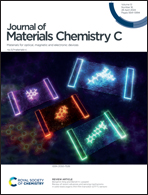Distribution of dual additives enables efficient semi-transparent layer-by-layer architecture of organic solar cells†
Abstract
Manipulating the active layer morphology to form ideal crystallinity and molecular orientation is a successful way of improving the performance of organic solar cells (OSCs). In this work, we combined the layer-by-layer (LBL) technique with dual additives introduction to precisely adjust the morphology on a PM6(FPy = 0.2):BTP-eC9 system. Importantly, 1-chloronapthalene (CN), which has a strong dipole moment, and poly(dimethylsiloxane-co-diphenylsiloxane), dihydroxy terminated (PDMDP), which has an amorphous structure, were introduced as dual additives into the active layer. We observed that dual additives of CN and PDMDP are the keys to controlling morphology and intermolecular interaction. Consequently, the highest power conversion efficiency (PCE) of 16.51% was achieved due to the increased short-circuit current density and fill factor when dual additives under mixing and heating are introduced in a single donor layer. Furthermore, this strategy yielded high performance semi-transparent OSCs with a PCE of 11.33% and an average visible transmittance of 19.28%. The proposed strategy also demonstrated a reasonable universality with other active material systems.



 Please wait while we load your content...
Please wait while we load your content...